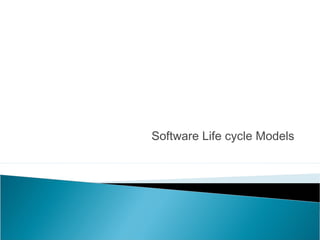
SOFTWARE models
- 1. Software Life cycle Models
- 2. The period of time that starts when a software product is conceived and ends when the product is no longer available for use. The software life cycle typically includes a requirement phase design phase implementation phase test phase installation and check out phase operation and maintenance phase, and sometimes retirement phase.
- 4. This model is easy to understand and reinforces The notion of “define before design” and “design before code” The model expects complete & accurate requirements early in the process, which is unrealistic
- 5. i. Difficult to define all requirements at the beginning of a project ii. Not suitable for accommodating any change iii. A working version of the system is not seen until late in the project’s life iv. It does not scale up well to large projects v. Real projects are rarely sequential.
- 6. te a m # 3 te a m # 2 b u s in e ss m o d e l in g te a m # 1 b u s in e s s data m o d e lin g m od e lin g p ro c e s s b u s in e s s m o d e l in g m o d e lin g d a ta m o d e lin g listen ap pl icatio n g e n era t io n to build/revise testin g & tu rn o ver p ro c es s custom er m ock-up d a ta m o d e lin g m o d e lin g a p p lic a tio n g e n e ra tio n p roce ss m o d e lin g te s tin g & tu rn o v e r a p p lic a tio n g e n e r a tio n custom er test-drives te s tin g m ock-up & tu r n o v e r 6 0 - 9 0 da ys Prototype RAD
- 7. 1)When prototype is shown to the user, he gets a proper clarity and 'feel' of the functionality of the software and he can suggest changes and modifications. 2) This type of approach of developing the software is used for non-IT-literate people. They usually are not good at specifying their requirements, nor can tell properly about what they expect from the software. 3) When client is not confident about the developer's capabilities, he asks for a small prototype to be built. Based on this model, he judges capabilities of developer. 4) Sometimes it helps to demonstrate the concept to prospective investors to get funding for project. 5) It reduces risk of failure, as potential risks can be identified early and mitigation steps can be taken. 6) Iteration between development team and client provides a very good and conductive environment during project. 7) Time required to complete the project after getting final the SRS reduces, since the developer has a better idea about how he should approach the project.
- 8. 1) Prototyping is usually done at the cost of the developer. So it should be done using minimal resources. It can be done using Rapid Application Development (RAD) tools. Please note sometimes the start-up cost of building the development team, focused on making prototype, is high. 2) Once we get proper requirements from client after showing prototype model, it may be of no use. That is why, sometimes we refer to the prototype as "Throw-away" prototype. 3) It is a slow process. 4) Too much involvement of client, is not always preferred by the developer. 5) Too many changes can disturb the rhythm of the development team.
- 9. Not an appropriate model in the absence of user participation. Reusable components are required to reduce development time. Highly specialized & skilled developers are required and such developers are not easily available.
- 10. System/information increment 1 engineering analysis design code test delivery of 1st increment increment 2 analysis design code test delivery of 2nd increment increment 3 analysis design code test delivery of 3rd increment increment 4 analysis design code test delivery of 4th increment ca lenda r time
- 11. They are effective in the situations where requirements are defined precisely and there is no confusion about the functionality of the final product. After every cycle a useable product is given to the customer. Popular particularly when we have to quickly deliver a limited functionality system.
- 12. This model has the same phases as the waterfall model, but with fewer restrictions. Generally the phases occur in the same order as in the waterfall model, but they may be conducted in several cycles. Useable product is released at the end of the each cycle, with each release providing additional functionality. Customers and developers specify as many requirements as possible and prepare a SRS document. Developers and customers then prioritize these requirements Developers implement the specified requirements in one or more cycles of design, implementation and test based on the defined priorities.
- 19. Component assembly model—the process to apply when reuse is a development objective Concurrent process model—recognizes that different part of the project will be at different places in the process Formal methods—the process to apply when a mathematical specification is to be developed Cleanroom software engineering—emphasizes error detection before testing
